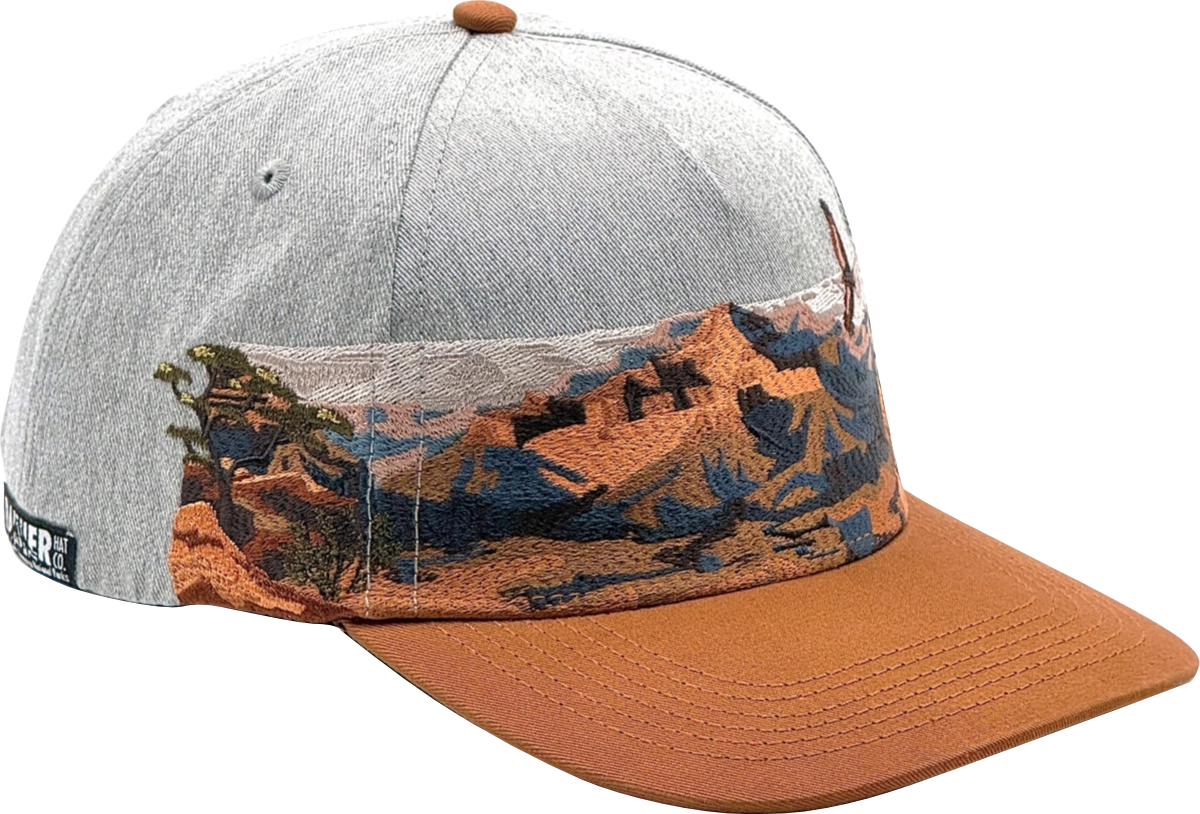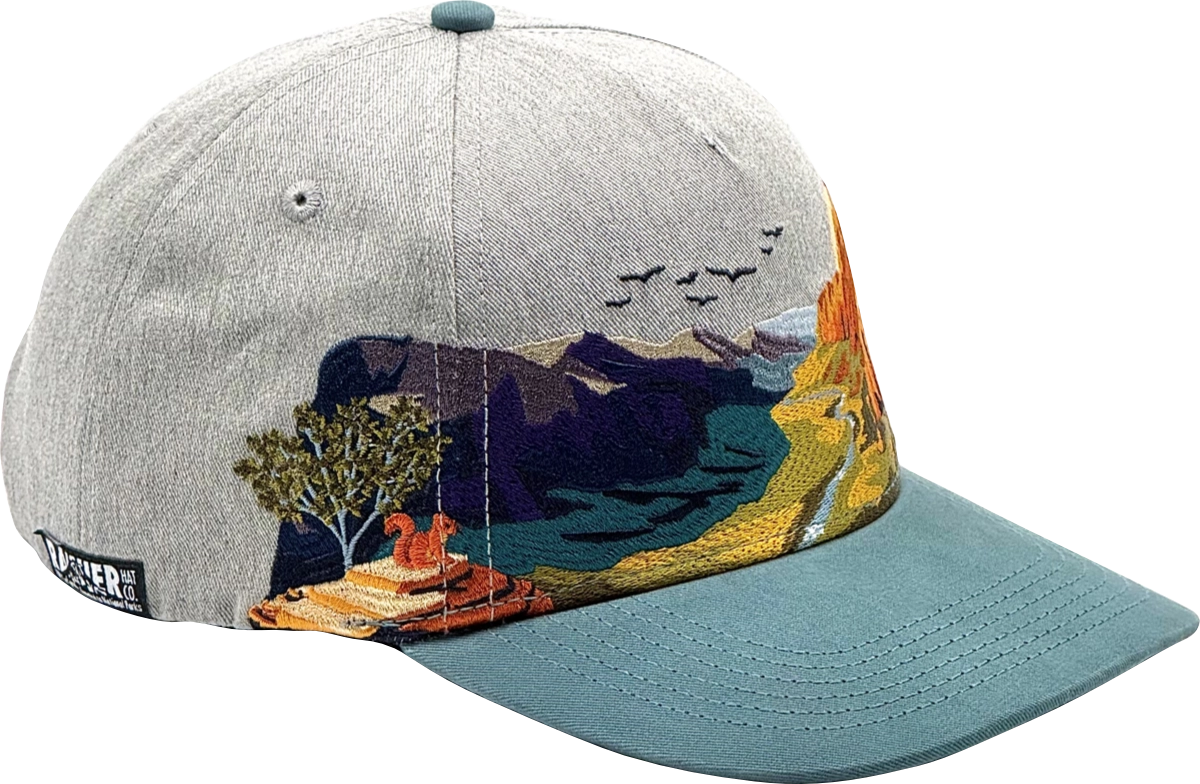Joshua Tree
National Park Hat
Details
- Embroidered panoramic design
- Adjustable snapback hat
- Structured mid-profile 5 panel
- Cotton, handwash
- Free shipping, free returns
- 100% of profits donated to National Parks
More National Parks
Our Mission
I'm Ian - from Seattle, and at Rainier Hat Co. we're dedicated to giving back to the places that inspire us every day. From the glaciers of Mount Rainier to the grand prismatic springs of Yellowstone, our national parks are treasures that deserve our support.
That's why we've made a commitment that goes beyond the norm: donating all our profits to these natural sanctuaries. It's not just about creating high-quality (and awesome) hats inspired by the beauty of the outdoors, it's about contributing to the preservation of these areas for future generations to enjoy.
Joshua Tree National Park Hat Inspiration
The inspiration for this Joshua Tree National Park hat comes from one of the park's most iconic and intriguing landmarks Skull Rock.
A naturally occurring granite formation that through years of erosion by wind and water, has come to resemble a human skull with hollowed-out "eye sockets." This unique geological feature embodies the mysterious and rugged beauty of Joshua Tree's desert landscape.
The hat captures Skull Rock set against the backdrop of the vast Mojave Desert and ajourned with the famously named Joshua Trees that are spread throughout the park.
Design Process
Creating these National Park hats with their panoramic embroidery is a detailed process going beyond simply buying and reselling bulk designs.
The first step is a deep dive into what makes each park unique. From the Bison of Yellowstone and the Roseated Spoonbills of the Everglades to the panoramic views of Angels Landing in Zion, our goal is to highlight the beauty of each park. We try to find a specific viewpoint in the park to show off and what we need to do to capture the feeling of being there. While sometimes we ad-lib a bit of the design to include other elements to capture the feeling of the park as a whole, we try hard to find an actual place in the park you can visit even giving you an exact Google maps QR code with every hat.
Then we get to designing! Embroidery is naturally limited in colors and we use a 15 color (the most you'll find) edgeless embroidery process which takes upwards of 90 minutes and over 60,000 stitches per hat, but allows us to show off every detail from that epic mountain range to the colorful flowers in your favorite park.
Finally the design get digitized for embroidery, a sample is made for any final tweaks, and we go to production getting these fantastic hats on your heads.
And 100% of our profits are donated right back to our National Parks .
Visit the Inspiration
To reach this Joshua Tree viewpoint, from either direction drive Park Boulevard toward the Jumbo Rocks area and watch for roadside parking near the Skull Rock sign. Skull Rock sits close to the road and can be seen from the parking area making this a short stop that fits easily into a scenic drive.
From the parking area walk a short distance on packed sand and rock to reach the viewpoint. The route is easy and does not require special equipment although sturdy shoes are recommended due to uneven ground. Visitors can view Skull Rock from multiple angles by walking around the formation while staying on durable surfaces to protect the desert environment.
Skull Rock is best visited during daylight hours when details are easier to see and parking is more available. Summer temperatures can be high so bring water and limit time outside while winter mornings can be cold.
Joshua Tree National Park
Joshua Tree National Park, located in southeastern California, is a vast protected area that spans nearly 800,000 acres of desert landscape. Established as a national monument in 1936 and later designated a national park in 1994, Joshua Tree is renowned for its unique geological features, diverse ecosystems, and rich cultural history.
The park is named after the Joshua tree (Yucca brevifolia), a distinctive plant species that is native to the Mojave Desert. These trees, with their twisted branches and needle-like leaves, were named by Mormon settlers who thought they resembled the biblical figure Joshua raising his hands in prayer.
Joshua Tree National Park is a convergence of two distinct desert ecosystems: the higher-elevation Mojave Desert and the lower-elevation Colorado Desert. This meeting of deserts creates a diverse environment that supports a wide variety of plant and animal life. Visitors can explore vast stands of Joshua trees, blooming wildflowers in the spring, and unique wildlife such as desert tortoises, coyotes, and bighorn sheep.
The park is also famous for its incredible rock formations, which attract rock climbers from around the world. The massive granite monoliths and boulders provide over 8,000 established climbing routes, making Joshua Tree a premier destination for both beginners and experienced climbers.
In addition to its natural wonders, Joshua Tree has a rich cultural history. The area has been inhabited by humans for at least 5,000 years, and evidence of Native American presence can be found throughout the park in the form of petroglyphs, pottery shards, and other archaeological sites.
Most Popular Hikes
Hidden Valley Trail
The Hidden Valley Trail is a popular, easy 1-mile loop that takes you through a scenic valley surrounded by massive rock formations. It's a great introduction to the park's unique geology and flora, and is suitable for hikers of all ages.
Ryan Mountain Trail
The Ryan Mountain Trail is a 3-mile out-and-back hike that leads to one of the highest points in the park. The summit offers panoramic views of Joshua Tree's valleys, rock formations, and distant mountain ranges. The trail is steep but well-maintained.
Barker Dam Trail
The Barker Dam Trail is an easy loop that features a historic dam, a rare sight of water in the desert, and opportunities to see wildlife. The trail also passes by petroglyphs left by Native Americans.
Fortynine Palms Oasis Trail
This 3-mile out-and-back trail leads to a secluded oasis of California fan palms. The hike traverses a desert landscape and provides a rewarding destination where you can relax in the shade of the palms.
Lost Horse Mine Trail
The Lost Horse Mine Trail is a 6.8 mile out-and-back hike to one of the best-preserved gold mines in the area. The trail offers insights into the park's mining history and panoramic views of the desert.
Joshua Trees
The Joshua tree (Yucca brevifolia) is a unique and iconic symbol of the Mojave Desert. These trees can grow up to 40 feet tall and live for hundreds of years. Their unusual shape and resilience have made them a subject of fascination and reverence. The trees play a crucial role in the desert ecosystem, providing habitat and food for numerous species, including the yucca moth, which is essential for the tree's pollination.
Stargazing in Joshua Tree
Joshua Tree National Park is renowned for its dark night skies, making it an excellent destination for stargazing and astrophotography. The park's remote location, low light pollution, and clear desert air provide optimal conditions for viewing stars, planets, meteor showers, and the Milky Way. Ranger-led night sky programs are often available, and visitors are encouraged to bring telescopes or binoculars to enhance their experience.











